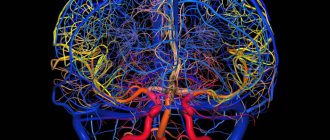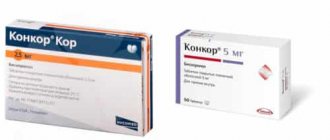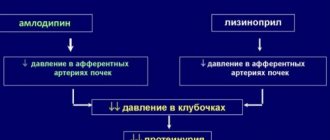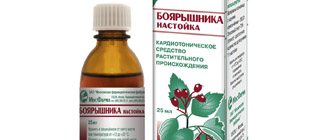Pharmacodynamics
Betaserc® (betahistine) acts mainly on histamine H1 and H3 receptors in the inner ear and vestibular nuclei of the central nervous system. Through a direct agonistic effect on H1 receptors of the vessels of the inner ear, as well as indirectly through an effect on H3 receptors, it improves microcirculation and capillary permeability, normalizes endolymph pressure in the labyrinth and cochlea. At the same time, betahistine increases blood flow in the basilar arteries. Betaserc® also has a pronounced central effect due to its influence on the H3 receptors of the vestibular nerve nuclei. Normalizes conductivity in the neurons of the vestibular nuclei at the level of the brain stem. The clinical manifestation of these properties is a decrease in the frequency and intensity of dizziness, a decrease in tinnitus, and an improvement in hearing if it is reduced.
The use of betaserc in the treatment of patients with dizziness of vascular origin
Chronic cerebral circulatory failure (CCF) (atherosclerotic, hypertensive encephalopathy) is most often diagnosed in people over 45 years of age, although its first signs can appear as early as 35 years of age.
The main symptoms of CNM are headache, dizziness, tinnitus, decreased memory and performance. In order for these signs to serve as a sufficient basis for establishing a diagnosis of CNM, a certain frequency of their occurrence (up to two to three times a week) and monitoring of the patient’s condition for two to three months are necessary. That is, there must be a “vascular history”.
•At the first, compensated, stage of the disease in patients with CNM, these complaints arise only after physical, emotional, intellectual overload, as well as extreme situations. When the cause of the painful condition is eliminated, after rest and light sedative therapy, the symptoms disappear.
•At the second, remitting stage, in people aged 45-55 years, signs of CNM appear after normal mental or physical stress. By the end of the working day, headaches, dizziness and other symptoms appear. Headaches can also occur at night and in the morning. They are most often localized in the occipital region. If the pain disappears or significantly decreases after walking or a slight muscular load, then it is likely due to venous stagnation, since most often the tone of the veins and the elasticity of the vascular wall decrease at this stage. After light physical activity, the tone of the venous walls increases slightly, congestion is eliminated, and patients note an improvement in their general condition.
At this stage of CNM, in addition to the above symptoms, the following signs appear: mood instability, tearfulness, general weakness, unsteadiness when walking, sleep disturbance, increased meteosensitivity. Periodically, paroxysms of severe headaches and dizziness occur, sometimes accompanied by nausea and vomiting, ataxia, as well as autonomic disorders: hot flashes, chills, sweating. After such attacks, general weakness and increased urination often occur. These are vegetative-vascular paroxysms with Meniere-like manifestations.
The neurological status usually does not reveal serious signs of damage to the nervous system; only diffuse neurological symptoms appear. However, patients almost always note impairments, mainly in mechanical memory and attention. These signs indicate inadequate blood supply to the brain stem, occipital lobes and cerebellum (vertebrobasilar basin) or the anterior parts of the brain - frontal, parietal, temporal lobes, subcortical formations (carotid basin). In this case, a neurasthenic syndrome is almost always determined, caused by weakness of the cerebral cortex, which, due to insufficient blood supply, reacts to hypoxia earlier than other parts.
•The third, subcompensated, stage of CNM is accompanied by constant symptoms characteristic of this disease. Patients note disturbances not only in mechanical, but also in logical and semantic memory. Signs of venous stagnation are observed in most patients. The course of the disease is accompanied by cephalgic, vegetative-vascular, vestibular, Meniere-like and other paroxysms. Hypertensive crises and transient cerebrovascular accidents, often in the vertebrobasilar region, are also characteristic. At this stage, intellectual-mnestic disorders can worsen to such an extent that patients are unable to perform not only their professional duties, but also simple self-care activities. The neurological status often reveals pathology of the cranial nerves, and changes in the reflex-motor, sensory and coordination systems. The patient's movements slow down, instability appears when walking, tremors of the head and limbs, and lack of coordination are observed.
•At the fourth, decompensated stage, acute cerebrovascular accidents and myocardial infarction may occur. Rough intellectual-mnestic changes and an increase in signs of dysfunction of subcortical structures are noted. The patient, as a rule, needs constant care due to paresis and paralysis of the muscles of the limbs, apraxia, ataxia, mental disorders, speech, pelvic organ function, bulbar and pseudobulbar phenomena.
An integrated approach is very important in the treatment of patients with CNM. The sooner the necessary measures are taken to improve cerebral blood flow, the more effective the treatment is.
First, the cause of the disease must be eliminated. In case of hypertension, it is necessary to prescribe adequate antihypertensive therapy, and in case of atherosclerosis - anti-sclerotic therapy. Comprehensive treatment of patients with CNM includes normalizing the patient’s body weight, increasing physical activity, limiting salt and liquid intake, giving up alcohol, smoking, spicy foods and smoked foods. A significant amount of vegetables, fruits, and lactic acid products should be included in the diet. It is necessary to ensure that the food is rich not only in vitamins, but also in microelements - potassium, calcium, selenium, etc.
Pathogenetic therapy for CNM includes drugs that improve cerebral blood flow, neotropics and drugs that normalize the “fluidity” of blood. There are a number of remedies that are used as symptomatic, but can also be used for pathogenetic treatment.
One of the most common and early symptoms of CNMC is dizziness. More than 80 diseases are known that are characterized by this symptom.
True dizziness is accompanied by a painful feeling of “rotation”, disturbance of orientation and balance. Patients experience anxiety and fear of falling, even if they are lying in bed. This condition may be worsened by nausea and vomiting. Dizziness occurs in attacks and lasts several hours and days, being a component of Meniere's disease and Meniere-like syndromes, which are caused by insufficiency of blood circulation in the vestibular formations of the brain stem. The latter is mainly supplied from the vertebrobasilar system. Generally accepted traditional remedies can improve cerebral blood flow in case of CNM and normalize the condition of the anterior (carotid) region. At the same time, higher nervous activity and speech are restored, reflex-motor and sensory disorders disappear. With a predominant circulatory disorder in the vertebrobasilar system, for a long time the patient is bothered by coordination and vestibular disorders, which are difficult to correct. Therefore, the search for new means that can restore the impaired function of the vestibular system is completely justified.
More than 30 years ago, a histamine-like substance was synthesized - betahistine dihydrochloride, which is presented on the pharmaceutical market under the name betaserc.
Intravenous histamine injections have been used to treat Meniere's disease for a long time. But due to the fact that this drug caused unwanted side effects, it was not widely used in this area. Betaserc, by increasing precapillary blood flow, improves microcirculation and, by suppressing the activity of the enzyme diamine oxidase, blocks the breakdown of endogenous histamine. It is assumed that betaserc increases the level of serotonin in the brain stem, which reduces the sensitivity of the vestibular nuclei. The complex mechanism of action of the drug allows for improved blood supply to the brain and, above all, stem structures, as well as increased blood flow in the inner ear.
Betaserc is available in the form of tablets that contain 16 mg of betahistine hydrochloride. The drug is rapidly absorbed, its maximum concentration in the blood is reached 3 hours after administration. The half-life is 3-4 hours, metabolites are excreted mainly in the urine. Taking into account the literature data on the long-term successful use of betaserc in Meniere's disease, we included this drug in the complex of treatment of patients with CNM who have predominant lesions of the vertebrobasilar system.
We observed 62 patients aged from 45 to 75 years (27 men and 35 women) with various stages of CNM. All patients underwent a general clinical examination. In 41 patients, CNMC was caused by hypertension, in 21 patients - by atherosclerosis. 54 people were treated at the clinic for nervous diseases. Eight patients were observed on an outpatient basis after examination in the hospital. Basically, the study included patients with stage II CNM (53 people), five patients with stage I and 4 patients with stage III. The duration of the disease ranged from three to 10 years. In almost all patients, the leading symptom of CNM was dizziness. All patients complained of noise or ringing in the ears, worsening during periods of dizziness, and nausea. 27 people had constant headaches, most often in the occipital region, and 12 had periodic headaches. In seven patients, vegetative-vascular paroxysms were noted, accompanied by headaches, coldness of the extremities, body tremors, darkening of the eyes, and photopsia.
In the neurological status, the following were noted: memory impairment in 48 people, attention impairment in 52, neurosis-like syndrome in 28, hearing loss in 17 (of which auditory neuritis was detected in eight), horizontal nystagmus in 10, impaired vestibular function of varying degrees - in 60, impaired coordination of movements - in 38 patients.
According to the literature, the vestibular system is one of the most sensitive to hypoxia. Therefore, dysfunction of this system, caused by changes in the peripheral and central structures of the vestibular analyzer and its projection zones in the cerebral cortex, are early indicators of the dynamics of processes arising as a result of certain changes in blood flow. At the same time, the transition to more severe forms and stages of vascular pathology is characterized by clear signs of disorders of vestibular function and impaired coordination of movements.
Since vestibular disorders are a fairly sensitive test that makes it possible to detect changes in the state of microcirculation of brain structures under the influence of treatment, complaints from patients were recorded describing linear and rotational movements of the body or objects, rocking, a feeling of lightheadedness, instability, falling, darkening in the eyes (signs of dizziness), which lasted more than 1 minute.
Traditional therapy for CNMC using all means usually used during etiological and pathogenetic treatment often brought relief to patients. However, dizziness, unsteadiness, and uncertainty when walking were observed in them longer than other symptoms of CNMC. Upon discharge from the hospital, complaints were usually noted indicating insufficient blood supply to the vestibular structures of the brain stem.
Betaserc was prescribed from two weeks to one month in the form of tablets at a dose of 24–48 mg/day. As a result of treatment, dizziness in some patients disappeared in the first days of taking the drug (32% of patients), in others it decreased gradually over 1-1.5 weeks. Of the 60 patients who experienced painful attacks of dizziness before treatment, 50 (81%) noted a significant improvement (the dizziness stopped), eight patients (13%) noted a slight improvement (decrease in the frequency of paroxysms), and in two patients (3%) the dizziness became short-lived. The subjects also reported a decrease in tinnitus and the disappearance of nausea. Objectively, there was an improvement in memory, attention, sleep, mood, as well as neurological symptoms. Reflexes were normalized in 20 patients (32%), nystagmus disappeared in eight (13%), sensory disorders decreased in nine (14%), coordination disorders in 24 (39%) patients, the frequency of vegetative-vascular paroxysms decreased in all observed. All patients were discharged from the hospital with an improvement in their general condition; they were recommended to continue taking betaserc on an outpatient basis for one month.
The study found that betaserc is effective in relieving dizziness caused by CNM predominantly in the vertebrobasilar region. The prescription of betaserc as an additional agent in the complex treatment of patients with CNM is justified and most appropriate in elderly people with vestibular and vegetative-vascular paroxysms, as well as in the early stages of the disease. In no case were any unwanted side effects noted.
Elimination of symptoms of vestibular function deficiency after treatment with betaserc is a clear criterion for restoring the functional ability of this analyzer and, consequently, improving blood supply to the brain.
Thus, in the complex treatment of patients with CNMC with dizziness, betaserc should be included as a prophylactic agent for the initial manifestations of the disease, as well as as a drug of choice at more serious stages in order to improve microcirculation in the brain stem structures.
Literature
- Akimov R. A. Initial manifestations of vascular diseases of the brain. - M., 1983.
- Aminev G. A., Truslakov V. V. Fluctuation of evoked potential and social adaptation of personality // Physiol. people - 1984. - No. 10 (3). — P. 465-468.
- Kislyakov V. A., Levashov M. M., Orlov I. V. Vestibular system // Physiology of sensory systems. - Part 2. - Ser. Guide to Physiology. - L.: Nauka, 1972. - P. 57-129.
Yu. Golovchenko, Doctor of Medical Sciences, Professor R. Adamenko, Candidate of Medical Sciences KMAPE named after.
P. L. Shupika, Kyiv








